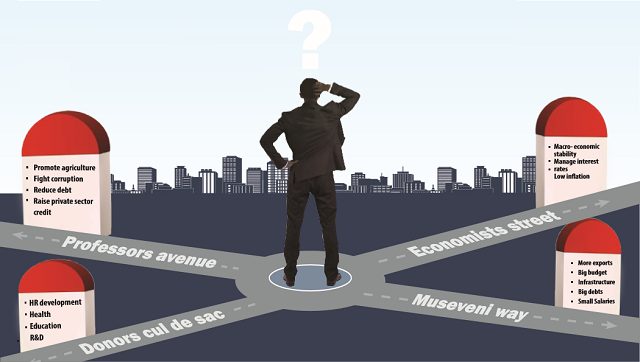
Here is why Ugandans are poorer today than yesterday
There is more bad news for the Uganda economy this April. According to the latest figures from the Uganda Bureau of Statistics (UBOS) and the Central Bank, the economy will not achieve the targeted 4.5% growth this financial year. It will be the fifth year in a row that the economic growth target will be missed. It also means you will be poorer. But how will you know that?
It is easy to know if you are poorer today than you were last year. You simply list the things you could afford to pay for last year that you cannot now. It is also easy to realise why you are poorer. Your company shut down over low sales and high costs of sales, you lost your job in a downsizing, your salary has not increased, the drought or army worms destroyed your farm, or your goods from Dubai do not sell as fast as they used to and your sponsor abroad no longer sends money. It could also be that none of the above has happened but prices of goods and services you used to buy have risen beyond your reach. The bad news is; things are likely to get worse this year and next unless some dramatic changes happen in the way the economy is managed.
According to officials at the Ministry of Finance and Planning and Bank of Uganda who design strategies to get Ugandans out of poverty, the economy needs to grow by 7% in order for Ugandans to get richer year on year. At that rate, coupled with population growth of 3.2%, it would take 20 years (up to 2037) for Ugandans to become as rich as Kenyans are today basing on Gross National Income (GNI) per person per year.
According to the World Bank, Kenya has a GNI Per Capita of about US$1,200 which makes it a lower middle income country compared to Uganda’s GNI per capita of US$700.
The trouble for Uganda is that, although these indicators get better year after year, the rate at which they are improving is lower than the required 7% growth per year.
In fact, policy makers at Ministry of Finance saw problems ahead from as far back as 2012 and lowered the economic growth rate targets to between 5 and 6%. That target too, however, has proved too high for Uganda.
Anticipated economic growth for FY 2016/17 which ends in June was initially set at 5% but it was later lowered even further to 4.5%. But according to latest figures from the Uganda Bureau of Statistics (UBOS), which the Governor of BoU, Emmanuel Tumusiime Mutebile confirmed recently, that too will not be possible.
The last time that Uganda’s economy grew at a rate above 5% was in 2011. At the time, the economy was growing at a rate between 4% and 2.5% per quarter. In the 2008/2009 FY when the economy was flying at growth rates of 10%, the quarterly rates were ranging between 6% and 10%. So what is the quarterly economic growth now? Not good at all.
In the First Quarter of FY2016, the economy grew by -0.1%. That figure by itself does not mean much as growth fluctuates. In fact, the Q2 figures announced on April 04 indicate that the economy swung back and grew by 0.8%. That is the bad news. It means the economy must now gallop by double that growth rate in the remaining unannounced six months if the economic growth rate of 4.5% is to be achieved.
But experts in this area see no chance of that happening.
“The numbers point towards a difficult situation of us reaching the 4.5% growth,” says Lawrence Bategeka, an economist, Member of Parliament and vice chairperson of the Parliamentary Committee on National Economy.
A top UBOS official told The Independent that failure to post over 1.5% growth rate for each of the two remaining quarters, will mean the 4.5% revised growth target will not be achieved.
 The Independent Uganda: You get the Truth we Pay the Price
The Independent Uganda: You get the Truth we Pay the Price



